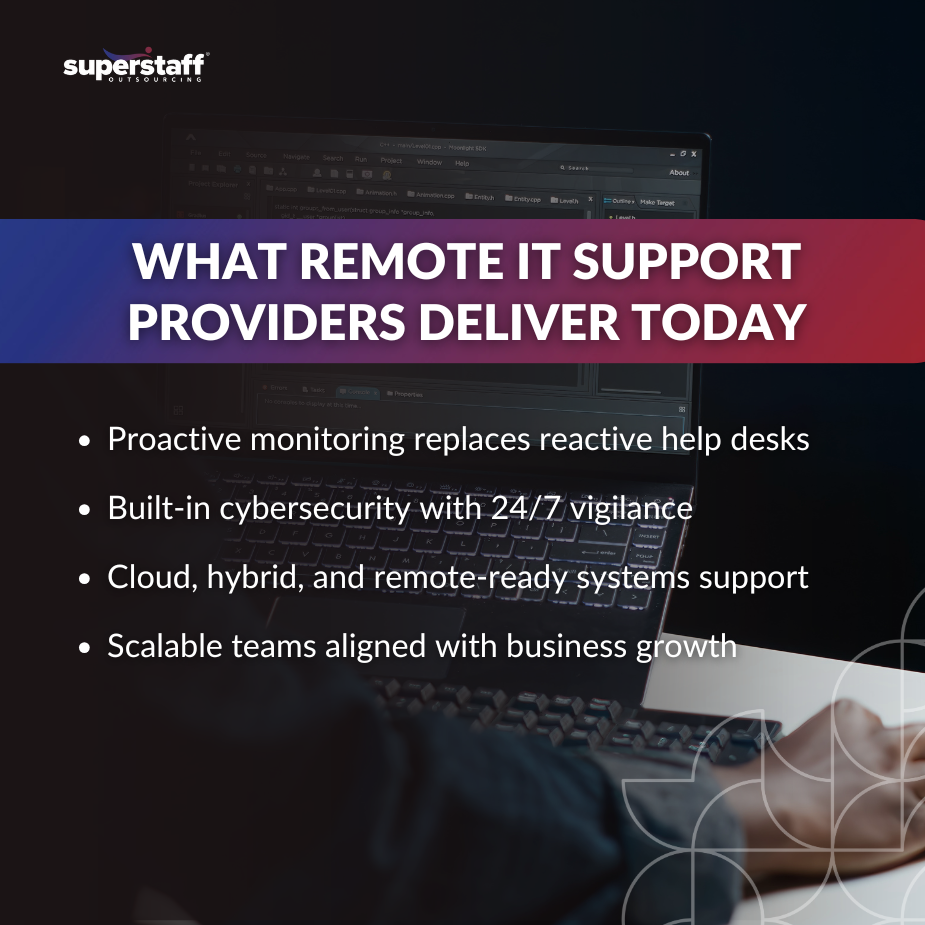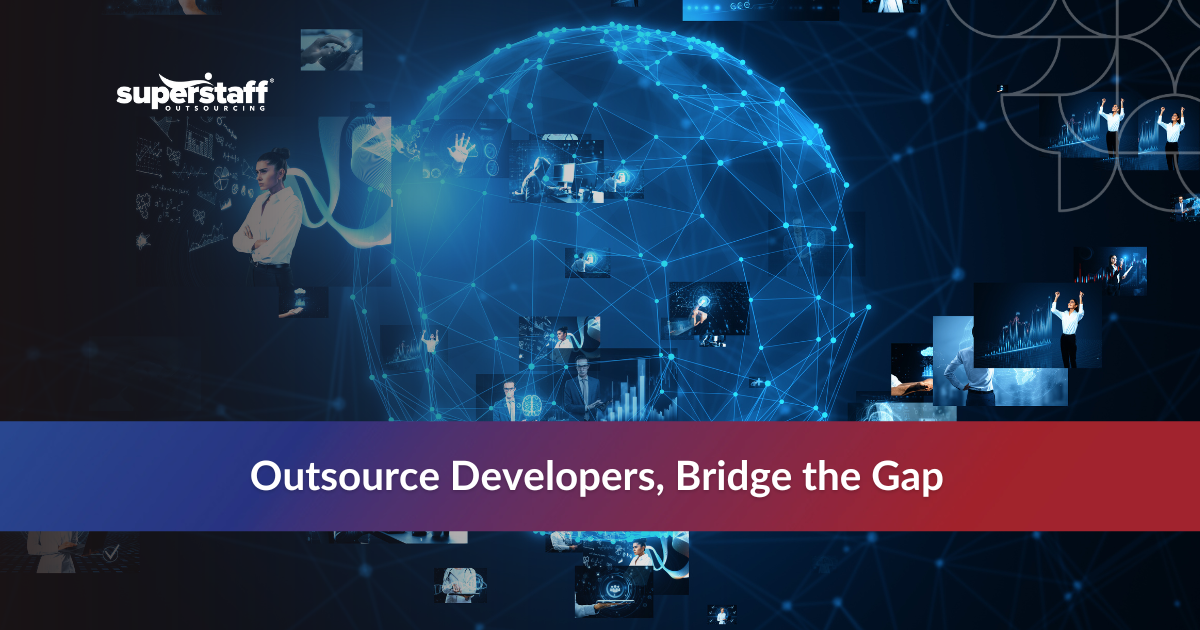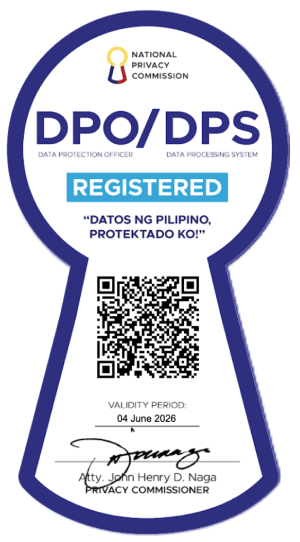
It’s no longer enough to have someone on standby to fix a broken server or reset a forgotten password. Today’s business environment moves too fast, demands too much, and leaves too little room for error. To stay ahead, companies need more than just reactive service. They need remote IT support providers that deliver end-to-end support, align with strategy, and help businesses scale with confidence. The old help desk model? It’s outdated. In this blog, we’ll explore how the new wave of IT support is changing the game and what businesses should expect from their outsourced partners.
From Reactive to Proactive: The Shift in IT Support Expectations

Traditional help desks thrived on one model—wait for something to go wrong, then fix it. But when a server goes down during a product launch or a network glitch locks out remote employees, waiting isn’t an option. Companies today expect their remote IT support providers to catch issues before they escalate. This shift from reactive to proactive isn’t just a buzzword—it’s a safeguard for business continuity.
Proactive monitoring tools now offer real-time visibility into systems. Instead of a client calling in a problem, automated alerts detect unusual activity or performance dips before users notice. Support teams can push updates, patches, and performance optimizations silently in the background. Some even use predictive analytics to forecast potential failures based on usage patterns. It’s a smart, forward-facing approach that protects productivity. And as the stakes rise, so does the need for support partners who operate at this level.
Cybersecurity Isn’t Optional — It’s Fundamental
The digital landscape is not just about speed and connectivity—it’s also a battleground. Businesses face a daily barrage of threats, and small to mid-sized companies are increasingly in the crosshairs. That’s why cybersecurity must be built into the DNA of any remote IT support provider.
Cyber readiness isn’t just about antivirus software or firewalls anymore. It’s about identifying vulnerabilities in real time and responding to threats before they cause damage. Leading providers deploy intrusion detection systems, perform routine vulnerability scans, and actively manage remote access protocols to prevent unauthorized entry. They help ensure compliance with data privacy regulations, especially for companies operating in regulated industries.
The cost of a breach is more than financial—it’s reputational. Businesses need partners who don’t just defend the perimeter but understand how every part of their IT infrastructure impacts their security posture. That level of support goes well beyond the traditional IT help desk.
Supporting Cloud-First, Hybrid, and Remote-Ready Environments
Cloud adoption isn’t a trend—it’s the new normal. And with remote work entrenched in global operations, remote IT support providers must now manage far more than office-based systems. They have to support flexible, hybrid infrastructures that span on-prem servers, public and private cloud platforms, and a globally distributed workforce.
Many businesses today juggle multiple cloud environments—AWS for data storage, Azure for enterprise software, Google Workspace for collaboration. Supporting that ecosystem requires deep knowledge of how cloud-native tools interact. It also demands agility, as applications evolve quickly, and downtime is rarely tolerated.
A capable remote IT support provider should know how to troubleshoot virtual desktops, ensure secure file sharing, and provide real-time assistance to users anywhere in the world. That includes helping teams transition to new tools, optimizing licenses, and integrating platforms for seamless operations. Cloud fluency isn’t optional—it’s expected.
Scalability and Flexibility: Matching IT Support With Business Growth
Business growth is rarely linear. One month, a company might onboard 50 new employees. The next, it might pivot operations to focus on a different region or product line. In these moments, IT support needs to flex without friction. That’s where remote IT support providers show their true value.
The ability to scale up—or down—quickly is a defining characteristic of a strong IT partner. Whether it’s supporting a product launch, entering a new market, or accommodating seasonal demand, the support structure should never become a bottleneck. A good provider can ramp up resources, provision new systems, and offer round-the-clock coverage without skipping a beat.
Some companies struggle to achieve this level of responsiveness in-house. Outsourcing to a flexible partner ensures they’re never stuck playing catch-up. It keeps operations smooth, no matter the curveballs thrown by the market. And it empowers internal teams to focus on strategic initiatives, not service tickets.
The Value of Specialized Expertise and Certifications
Modern business IT isn’t just about desktops and printers anymore. It’s about deploying machine learning models, managing multi-layered security stacks, and integrating platforms with hundreds of APIs. That level of complexity demands specialized knowledge, and the best remote IT support providers bring that to the table.
Top-tier providers invest in certifications like AWS Certified Solutions Architect, Cisco CCNA, or CompTIA Security+ to ensure their teams stay ahead. But beyond credentials, they also bring deep experience across industries. A provider that understands healthcare tech, for example, knows the ins and outs of HIPAA compliance. One that supports fintech clients will be well-versed in real-time transaction security.
Access to specialists—whether in cybersecurity, DevOps, or data analytics—lets businesses tap into skills they may not need full time but still require for mission-critical tasks. It’s a smarter, more cost-effective way to stay competitive without inflating internal headcount.
User Experience and IT Support Go Hand in Hand
IT support doesn’t just keep systems running—it shapes how employees experience their workday. Slow resolutions, poor communication, and a lack of empathy can wear down teams and hinder productivity. That’s why the user experience must be a central focus for remote IT support providers.
The difference between a good and great provider often comes down to human touch. It’s about getting the issue resolved on the first contact, explaining technical steps clearly, and treating every ticket like it matters. For global companies, that also means multilingual support and cultural fluency that aligns with diverse teams.
A responsive IT partner boosts morale, enhances onboarding, and even reduces churn. And in a remote or hybrid workplace, that support often defines how smoothly the entire organization functions. In many ways, IT becomes the face of internal culture—so it needs to reflect the values a business holds dear.
Strategic IT Support: Aligning Tech With Business Goals
IT isn’t just about maintenance anymore. It’s a key driver of strategic decisions, from automation to customer experience. The best remote IT support providers understand this shift and step into the role of advisor—not just technician.
Whether it’s helping a company plan its infrastructure to support global expansion or advising on which collaboration tools will scale best with headcount, these providers become embedded in strategic conversations. They help forecast costs, ensure tech stacks remain lean, and identify areas where automation can free up human bandwidth.
This level of engagement transforms IT from a cost center into a growth enabler. And for midmarket businesses navigating digital transformation, that perspective is invaluable. It ensures technology serves the business—not the other way around.
Why SuperStaff Is More Than a Help Desk
At SuperStaff, we don’t believe IT support should live in the shadows. Our teams don’t just answer tickets—they partner with clients to build smarter, more resilient operations. As a trusted remote IT support provider, we offer round-the-clock service, industry-specific expertise, and the flexibility to scale with your growth.
From securing hybrid environments to supporting strategic initiatives, we do more than fix issues. We anticipate them. Our people integrate seamlessly with in-house teams, offering both technical skill and collaborative spirit. Whether you’re launching a new product or managing a complex cloud migration, SuperStaff is equipped to support every step of your journey.
We understand that businesses are looking not just for a vendor, but a partner. And that’s exactly what we deliver.
Conclusion: The Future of Remote IT Support Providers
The modern business landscape demands more than help desk support. It requires remote IT support providers who can keep operations running, defend against threats, enable growth, and align with strategy. That means moving beyond tickets and troubleshooting to deliver real value through proactive service, cloud expertise, cybersecurity readiness, and deep technical knowledge.
Companies that embrace this new model reduce downtime, improve employee experience, and build IT ecosystems that flex as fast as their business does. They discover the true power of working with an outsourced IT support provider that doesn’t just react—but leads.
If you’re ready to experience how remote IT support providers reduce downtime and costs while fueling long-term growth, it’s time to talk to SuperStaff. We bring the people, tools, and mindset to help you go beyond the help desk. Let’s build something smarter together.






